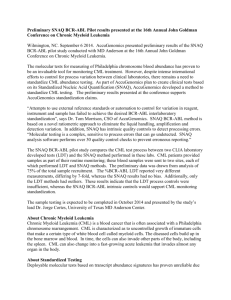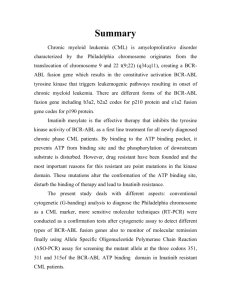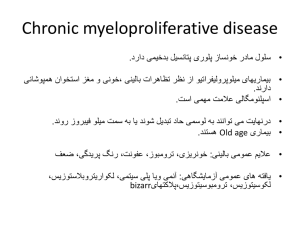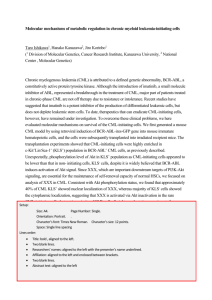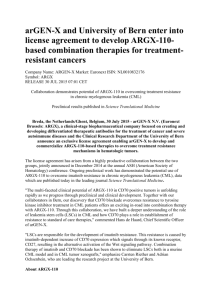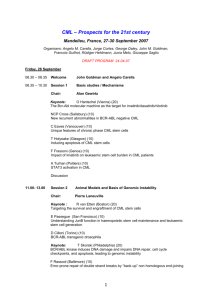Chronic Myeloid Leukemia and other
advertisement
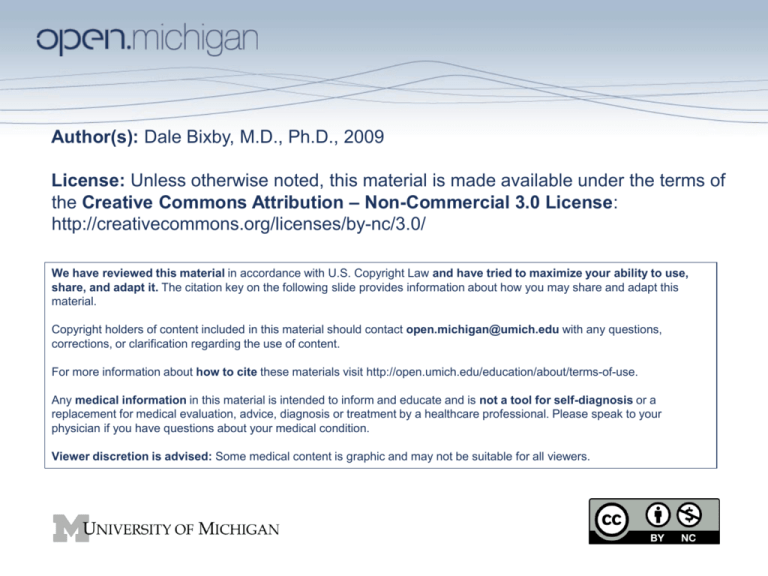
Author(s): Dale Bixby, M.D., Ph.D., 2009
License: Unless otherwise noted, this material is made available under the terms of
the Creative Commons Attribution – Non-Commercial 3.0 License:
http://creativecommons.org/licenses/by-nc/3.0/
We have reviewed this material in accordance with U.S. Copyright Law and have tried to maximize your ability to use,
share, and adapt it. The citation key on the following slide provides information about how you may share and adapt this
material.
Copyright holders of content included in this material should contact open.michigan@umich.edu with any questions,
corrections, or clarification regarding the use of content.
For more information about how to cite these materials visit http://open.umich.edu/education/about/terms-of-use.
Any medical information in this material is intended to inform and educate and is not a tool for self-diagnosis or a
replacement for medical evaluation, advice, diagnosis or treatment by a healthcare professional. Please speak to your
physician if you have questions about your medical condition.
Viewer discretion is advised: Some medical content is graphic and may not be suitable for all viewers.
Citation Key
for more information see: http://open.umich.edu/wiki/CitationPolicy
Use + Share + Adapt
{ Content the copyright holder, author, or law permits you to use, share and adapt. }
Public Domain – Government: Works that are produced by the U.S. Government. (17 USC § 105)
Public Domain – Expired: Works that are no longer protected due to an expired copyright term.
Public Domain – Self Dedicated: Works that a copyright holder has dedicated to the public domain.
Creative Commons – Zero Waiver
Creative Commons – Attribution License
Creative Commons – Attribution Share Alike License
Creative Commons – Attribution Noncommercial License
Creative Commons – Attribution Noncommercial Share Alike License
GNU – Free Documentation License
Make Your Own Assessment
{ Content Open.Michigan believes can be used, shared, and adapted because it is ineligible for copyright. }
Public Domain – Ineligible: Works that are ineligible for copyright protection in the U.S. (17 USC § 102(b)) *laws in your
jurisdiction may differ
{ Content Open.Michigan has used under a Fair Use determination. }
Fair Use: Use of works that is determined to be Fair consistent with the U.S. Copyright Act. (17 USC § 107) *laws in your
jurisdiction may differ
Our determination DOES NOT mean that all uses of this 3rd-party content are Fair Uses and we DO NOT guarantee that
your use of the content is Fair.
To use this content you should do your own independent analysis to determine whether or not your use will be Fair.
Chronic Myeloid Leukemia and other
Myeloproliferative Neoplasms (MPNs)
Dale Bixby, M.D., Ph.D
Clinical Assistant Professor
Assistant Program Director
Division of Hematology and Oncology
Department of Internal Medicine
University of Michigan
Winter 2010
Definitions
Myeloproliferative Neoplasms (MPNs): are a group of
clonal myeloid neoplasms in which a genetic alteration
occurs in a hematopoietic progenitor cell leading to its
proliferation resulting in an increase in the peripheral blood
white blood cells (WBCs), red blood cells (RBCs),
platelets, or a combination of these cells.
Hematopoietic Progenitors and MPNs
Genetic
Mutation
National Cancer Institute
More Definitions
The type of disorder is often based on the predominant cell line that is
affected, but because blood counts are often abnormal in more than one
cell line, diagnoses based upon blood counts alone may be inaccurate.
Four Main MPNs:
1. Chronic Myelogenous Leukemia (CML)
2. Polycythemia Vera (PV)
3. Essential Thrombocytosis (ET)
4. Primary Myelofibrosis (PMF)
Additional MPNs:
1. Systemic Mastocytosis
2. Hypereosinophilic Syndrome
3. Chronic Myelomonocytic Leukemia
4. Chronic Neutrophilic Leukemia
5. Chronic Eosinophilic Leukemia
MPN overview
In CML, the predominant feature is a leukocytosis with a left shift. A mild anemia,
normal to elevated platelet count, and a peripheral blood basophilia is often
seen.
In PV, the predominant features are elevated red blood cell indicies (RBC count,
hemoglobin, and hematocrit). Patients often also have a mild leukocytosis and
thrombocytosis.
In ET, the predominant feature is an elevated platelet count. Patients also often
have a mild leukocytosis and polycythemia.
In PMF, the predominant feature is evidence of extramedullary hematopoiesis in the
form of hepatomegaly, splenomegaly, and lymphadenopathy. Patients often
have a mild anemia, but their WBC and platelet counts can be quite variable.
Leukoerythroblastosis (tear drops, nucleated RBCs and early myeloid
progenitors (including blasts) are often seen in the peripheral blood.
Clonal Genetic Abnormalities Define Many MPNs
Figure showing
classification and
molecular
pathogenesis of
the MPD removed
See online at: http://img.medscape.com/fullsize/migrated/563/885/nrc563885.fig1.gif
Original source: Levine et al. Role of JAK2 in the pathogenesis and therapy
of myeloproliferative disorders. Nature Reviews – Cancer 2007;7:673-683
Chronic Myeloid Leukemia (CML)
Epidemiology of CML
Approximately 5,050 cases in the U.S. in 2009 (11% of all leukemias) with
an incidence that increases significantly with age (median age ~ 55)
Risk Factors include:
▪ prior high dose radiation exposure (WW II / Chernobyl / etc…)
▪ exposure to certain organic solvents (benzene)
▪ age
▪ gender (male > female)
A very small percentage (< 0.1%) of individuals can express Bcr-Abl but not
develop CML (wrong cell of origin, multiple genetic mutations leading to
non-viability, immune surveillance)
CML – Pathophysiology –
the Philadelphia Chromosome
Source Undetermined
Source Undetermined
Bcr-Abl and CML
Source Undetermined
Source Undetermined
Multiple Breakpoints in Bcr-Abl
Sources Undetermined
Pathophysiologic Result
of the Expression of Bcr-Abl
Stephen B. Marley and Myrtle Y. Gordon. Chronic myeloid
leukaemia: stem cell derived but progenitor cell driven
Clinical Science (2005) 109, (13*25)
Bcr-Abl expression alone is necessary and sufficient for the development of CML
Chronic Myeloid Leukemia
Clinical Presentation
▪ Asymptomatic (~ 30%)
▪ Fatigue, weight loss, fever
▪ Abdominal fullness, pain and/or early satiety due to splenomegaly
(~ 50-90%)
▪ Easy bruising and purpura
▪ Leukostasis
▪ Pulmonary symptoms
▪ Neurologic symptoms
CML – Peripheral Blood and BM Findings
Peripheral smear can only give a presumptive
diagnosis of CML [you need to confirm the t(9;22)]:
1) leukocytosis with a ‘left shift’
2) normocytic anemia
3) thrombocytosis in 50% of pts
4) absolute eosinophilia with a normal % of Eos.
5) absolute and relative increase in basophils
6) LAP score is low (not frequently employed)
Source Undetermined
Diagnosing Chronic Myeloid Leukemia
Diagnostic Considerations in
Chronic Myeloid Leukemia
Demonstrating the presence of the t(9;22) or its gene product is
absolutely essential in diagnosing a patient with CML
Karyotyping in CML
1) Allows for the diagnosis of CML
2) Requires a bone marrow aspirate for
optimal metaphases
3) Allows for evaluation of clonal evolution as
well as additional chromosomal abnormalities
in the non-Ph+ clones
4) Occasional cryptic and complex karyotypes
can result in the missed identification of the
t(9;22)
Source Undetermined
Diagnostic Considerations in
Chronic Myeloid Leukemia
Fluorescence in-situ hybridization
(FISH) in CML:
1) Allows for the diagnosis of CML
2) Does not require a bone marrow aspirate for
optimal results
3) Allows for the identification of potential
duplications of the Ph chromosome
4) Allows for the identification of the loss of the
der (9) chromsome
5) Allows for the identification of cryptic
translocations involving Bcr-Abl
Bcr- Ch 22
Abl – Ch 9
Bcr-Abl Fusion
Source Undetermined
FISH in CML
Source Undetermined
Bcr- Ch 22
Abl – Ch 9
Ch 9
Ch 22
Source Undetermined
Bcr-Abl Fusion
Red → Bcr probe
Green → Abl Probe
Yellow → fusion of Bcr and Abl
Diagnostic Considerations in
Chronic Myeloid Leukemia
Bcr-Abl
cDNA
Quantitative RT-PCR
for Bcr-Abl in CML
Bcr
Abl
1) Allows for the diagnosis of CML
2) Does not require a bone marrow aspirate for
optimal results
3) Can quantify the amount of disease
4) Allows for the identification of cryptic
translocations involving Bcr-Abl
5) Many primers sets only detect the p190 and/or
the p210 translocation and may miss the p230
or alternative translocations
Source Undetermined
Quantitative RT-PCR for Bcr-Abl in CML
High Concentration
Moderate
Concentration
Amount of
Fluorescence
Low Concentration
0
3
6
9
12
15
18
21
24
PCR Cycle Number
CT
(~13.5)
D. Bixby
27
CT
(~28)
30
33
36
Disease Diagnosis and
Monitoring in CML
Test
Cytogenetics
Target
Tissue
Sensitivity (%)*
Ph chromosome
BM
1-10
Use
▪
▪
FISH
RT-PCR
Juxtaposition of
bcr and abl
PB/BM
bcr-abl mRNA
PB/BM
0.5-5
Confirm diagnosis of CML
Evaluate karyotypic
abnormalities other than Ph
chromosome (ie, clonal
evolution)
▪
Confirm diagnosis of CML
Routine monitoring of
cytogenetic response in
clinically stable patients
▪ Routine measurement of
MRD
▪
0.0001-0.001
▪
Routine measurement of
MRD
▪ Determine the breakpoints of
the fusion genes
*Number of leukemic cells detectable per 100 cells.
BM = bone marrow; FISH = fluorescence in situ hybridization; PB = peripheral blood;
MRD = minimal residual disease; RT-PCR = reverse transcriptase polymerase chain reaction.
Wang et al. Genes Chromosomes Cancer. 2001;32:97
Chronic Myeloid Leukemia Diagnostic Criteria for the 3 Phases of the Disease
D. Bixby
Therapeutic Options in
Chronic Myeloid Leukemia
History of CP-CML Therapies
→ Interferon – α +/- AraC
→
early Interferon – α trials
→ intensive chemotherapy
→ Hydrea, or radiation therapy
or Busulphan
Quintas-Cardama et al. Mayo Clin Proc 2006; 81(7):973-988
Imatinib (Gleevec, Novartis)
a small molecule tyrosine kinase inhibitor
X
Source Undetermined
Frontline Therapy in Chronic Phase Chronic Myeloid Leukemia
Hochhaus A, Druker B, Larson R, et al. Blood (ASH Annual
Meeting Abstracts), Nov 2007; 110: 25.
Hochhaus A, O’Brien S, Guilhot F, et al., Leukemia (2009)
23, 1054–1061.
Treatment Milestones for CML
Amount of Dz
Definitions of Responses to Treatments
Hematologic Response
1X1012
1X1011
Complete Hematologic response
1) Normal PB counts (WBC < 10 and plt < 450)
2) Normal WBC differential
3) No Dz symptoms
4) Normalization of the size of the liver and spleen
Cytogenetic Responses: Ph+ Metaphases
1X1010
1) complete: 0%
2) partial: 1% - 35%
3) minor: 36% - 65%
4) minimal: 66% - 95%
5) none: 96% - 100%
Molecular Responses: ratio of Bcr-Abl/Abl
Major Molecular Response
3-log10 reduction from initial diagnosis sample
(i.e. 25 →0.025)
D. Bixby
1X10 8-9
Imatinib has Revolutionized
the Treatment of CML –
IRIS Trial1
98%
96%
92%
85%
87%
69%
1. Newly diagnosed CML patients were randomized to receive either Imatinib 400 mg daily or Interferon-α at approximately 5X106 U/day
as well as Ara-C 20 mg/m2 d1-10 q 8 days. Graph shows outcomes of 553 pts randomized to Imatinib.
Druker et al. N Engl J Med 2006; 355(23): 2408-2417.
2009 ELN Recommendations
for Response Assessment for Treatment
Baccarani M, Cortes J, Pane F, et al., J Clin Oncol. 2009 Dec 10;27(35):6041-51.
Mechanisms of Imatinib Resistance
Primary resistance
▪failure to achieve preset hematologic and/or
cytogenetic milestones
▪IRIS data indicates a rate of ~ 15%
by failing to a achieve a PCyR at 12 months
and 24% by failing to achieve a CCyr
by 18 months of therapy.
▪rates higher in accelerated and blast phase
disease
Secondary resistance
▪loss of a previously achieved hematologic
or cytogenetic milestone
▪rates may be 10-15% on Imatinib, but
become rarer as time on therapy progresses
▪rates higher in accelerated and blast phase
disease
Resistance Mechanisms
1) Bcr-Abl Kinase mutations
▪ > 50 known mutations within Abl sequence
which inhibits Imatinib from binding
▪ mutations identified in 30-80% of individuals
with resistant disease
2) Bcr-Abl duplication
duplication of the Bcr-Abl sequence has been
identified in cell lines with Im resistance
3) Pgp over-expression
export pump of many chemotherapeuticsleading
to lower intracellular Im concentration
4) hOct-1 under-expression
import pump for Im which may lead to lower
intracellular levels of IM
5) Src-Family kinase (SFK) expression
activation may circumnavigate the Bcr-Abl
‘addiction’ of the transformed cell
Bcr-Abl
D. Bixby
imatinib
Mut. Bcr-Abl
imatinib
Mut. Bcr-Abl
dasatinib
Redaelli S, Piazza R, Rostagno R, et al. Activity of bosutinib, dasatinib, and nilotinib against 18
imatinib-resistant BCR/ABL mutants. J Clin Oncol. 2009;27(3):469-471, PMID: 19075254.
Imatinib Poorly Control Advanced
Phase Disease
Kamb et al. The value of early detection, the right drug and the right patient population. Nature Reviews Drug Discovery 2007; 6: 115-120.
Treatment Options for Resistant Disease
1) Dose Escalation of imatinib
2) Second Generation TKIs
3) Bone Marrow Transplant
4) Clinical Trial Participation
Dose Escalation of imatinib
START-R Trial1
Patients resistant to 400mg-600 mg of imaitnib were treated with either 70 mg BID of
dasatinib or 800 mg of imaitnib
▪ primary endpoint of the trial was the rate of MCyR at 12 weeks and this was equal
(D=36%; IM=29%; p=.40)
▪ At a minimum follow-up of 2 years, dasatinib demonstrated higher rates of:
▪ complete hematologic response (93% vs 82%; P = .034)
▪ major cytogenetic response (MCyR) (53% vs 33%; P = .017)
▪ complete cytogenetic response (44% vs 18%; P = .0025)
The depth of the previous response to imatinib may be associated with the proportion
of patients responding to dose escalation. Patients having achieved a prior major
cytogenetic response (MCyR) with imatinib reported a greater than 50% chance of re
achieving that response with high-dose imaitnib, yet only 7% of patients who did not
achieve any cytogenetic response on standard dose imatinib were able to achieve a
MCyR.
Kantarjian H, Pasquini R, Levy V, et al. Dasatinib or high-dose imatinib for chronic-phase chronic myeloid leukemia resistant to imatinib at a dose of 400 to 600 milligrams
daily: two-year follow-up of a randomized phase 2 study (START-R). Cancer. 2009.
Second Generation
Tyrosine Kinase Inhibitors (TKIs)
The FDA has approved 2 additional oral TKIs for the treatment of
imatinib relapsed/refractory or imatinib intolerant CML
dasatinib (Sprycel – BMS)
nilotinib (Tasigna – Novartis)
▪ oral multi-kinase inhibitor
▪ ~ 325 times more potent than IM
▪ active against the ‘open’ and ‘closed
confirmation of Bcr-Abl
▪ active against many of the identified
kinase domain (KD) mutations
▪ active against the SFKs
▪ may not be a substraight for Pgp or
hOct-1
▪ oral multi-kinase inhibitor
▪ ~ 30 times more potent than IM
▪ active against only the closed
confirmation of Bcr-Abl
▪ active against many of the KD
mutations
▪ not active against the SKFs
▪ may not be a substraight for
hOct-1
Bone Marrow Transplantation
Allogeneic bone marrow transplant remains the only known curative option in CML
Associated with an increased morbidity and mortality (TRM -10%-30%)
Therefore, not typically applied for upfront therapy for CML
▪ considered only in cases of matched-related Txp for extremely young pts (pediatrics)
However, often considered in those with relapsed/refractory disease to TKI based
therapies
▪ efficacy of the transplant dependent upon the phase of the disease at the time of the
transplant: CP>AP>BP
Clinical Trial Options in CML
D. Bixby
Polycythemia Vera (PV)
Polycythemia
A hematocrit greater than 48%(♀) or 52 % (♂) constitutes polycythemia
Likewise, a hemoglobin of >16.5 g/dL (♀) or >18.5 g/dL (♂) raises the suspicion for polycythemia
Absolute polycythemia is characterized by an increase in red blood cell (RBC) mass
▪ Five common causes include: 1) primary polycythemia, 2) hypoxia, 3) carboxyhemoglobinemia,
4) cushing’s syndrome or corticosteroids, and 5) erythropoietin-secreting tumors
Relative polycythemia is characterized by a decrease in plasma volume.
Two common causes:
▪ Dehydration (e.g., from vomiting, diarrhea, excessive sweating, or diuretics) can deplete plasma
volume, leading to a relative polycythemia.
▪ Stress erythrocytosis (Gaisböck’s polycythemia) actually results from contraction of the plasma
volume and is therefore a misnomer. This benign disorder is seen most often in hypertensive,
obese men.
Red Blood Cell Mass Assay:
▪ used to distinguish an absolute versus a relative polycythemia
▪ does not subclassify absolute polycythemias
Clinical Presentation of Primary PV
Symptoms:
▪ non-specific complaints: headache, weakness, dizziness, and excessive sweating
▪ pruritus, especially following a warm bath or shower
▪ erythromelalgia, or burning pain in the feet or hands accompanied by erythema,
pallor, or cyanosis
▪ symptoms related to either an arterial or venous thrombosis (CVA, MI, DVT,
Budd Chiari syndrome or other portal venous thrombosis)
Signs:
▪ facial plethora (ruddy cyanosis)
▪ splenomegaly
▪ hepatomegaly
▪ gouty arthritis and tophi
Diagnostic Criteria for Primary PV
Polycythemia Vera Study Group (PVSG) Criteria for PV
Minor Criteria
Major Criteria
▪ Elevated RBC mass
>36 cc/kg in men
>32 cc/kg in women
▪ Oxygen saturation >92%
▪ Splenomegaly
▪ Plt count > 400,000
▪ WBC > 12,000
▪ Elevated LAP score (>100)
▪ Serum vitamin B12 >900 pg/mL or serum
unbound B12 binding capacity >2,200 pg/mL
→ All 3 major criteria OR the first 2 major and any 2 minor criteria ←
2008 WHO Diagnostic Criteria for Primary Polycythemia Vera
Major Criteria
1) Hgb > 18.5g/dl (♂) or 16.5g/dl (♀)
or
Hgb or Hct > 99%
or
Hgb > 17g/dl (♂) or 15 g/dl (♀) and
a documented increase of 2 g/dl
or
RBC mass > 25% of mean normal
Minor Criteria
1) Bone marrow trilineage expansion
2) Subnormal EPO level
3) Endogenous erytyhroid colony growth
2) Presence of a JAK2 V617F or similar
mutation
→ two major or first major and two minor criteria ←
Tefferi et al. Leukemia (2008) 22, 14–22
JAK2 Mutations Seen in Three Different MPNs
Figure showing
classification and
molecular
pathogenesis of
the MPD removed
See online at: http://img.medscape.com/fullsize/migrated/563/885/nrc563885.fig1.gif
Original source: Levine et al. Role of JAK2 in the pathogenesis and therapy
of myeloproliferative disorders. Nature Reviews – Cancer 2007;7:673-683
JAK2 Mutations and MPNs
▪ Receptor Tyrosine Kinase - maps to chromosome 9p
▪ Valine to phenylalanine substitution at amino acid 617 (V617F) in
pseudokinase domain of JAK2 allows for the constitutive
activation of the receptor
▪ Somatic acquired mutation
▪ High incidence in PCV (~95%)
▪ Not present in every patient with PCV
▪ Lower incidence in ET (~50%) and PMF (~50%)
JAK2 Mediated Signaling
Nature Reviews | Cancer
Outcomes and Treatment of PV
Survival outcomes in PV are affected by:
1) hyperviscosity and associated ischemic sequela
2) thromboses independent of hyperviscosity
3) transformation to myelofibrosis or acute myeloid leukemia (~3%-10%)
Therapeutic Options in PV:
1) Low Risk: phlebotomy (to an Hct of <45 in ♂ and <42 in ♀) + low dose aspirin
(81 mg daily) – decreases risk of thrombosis
2) High Risk: phlebotomy + ASA + hydroxyurea
High Risk for Thrombosis:
▪ age over 70
▪ prior thrombosis
▪ platelet count >1,500,000/μl
▪ presence of cardiovascular risk factors
JAK2 Inhibitors in MPNs
A number of inhibitors of the JAK2 kinase have been developed and inhibit the
proliferation and survival of JAK2 V617F transformed cell lines in-vitro
Clinical studies (Phase I and Phase II) have been initiated and demonstrate some
symptomatic improvement as well as improvement in splenomegaly in a number
of patients, but unlike CML, the percentage of JAK2+ progenitor cells have not
been significantly altered. However, a large number of trials continue at this time.
Leads to speculation that JAK2 may not be sufficient for the development of MPNs
and there may be an earlier genetic mutation that is driving the phenotype.
Essential Thrombocythemia (ET)
Thrombocytosis
Definition: thrombocytosis is defined as a platelet count > 450,000 cells/μL
Etiology of Thrombocytosis
Primary - if the thrombocytosis is caused by a myeloproliferative
neoplasm, the platelets are frequently abnormal and the patient may be
prone to both bleeding and clotting events.
Secondary - if thrombocytosis is secondary to another disorder
(reactive), even patients with extremely high platelet counts (e.g., >
1,000,000 cells/μl) are usually asymptomatic.
Differential Diagnosis of secondary thrombocytosis:
1. Malignancies
2. Infections and inflammatory disorders (e.g., Crohn’s disease)
3. Post surgical status
4. Connective tissue disorders
5. Iron deficiency anemia
6. Splenectomy
7. Recovery of the bone marrow from a stress (chemotherapy or alcohol)
8. Essential Thrombocythemia
Clinical Presentation of
Essential Thrombocythemia (ET)
Asymptomatic (~ 30-50%)
Vasomotor symptoms including headache, syncope, atypical chest pain,
acral paresthesia, livedo reticularis, and erythromelalgia
Thrombosis and hemorrhage occur to various degrees in 5%-25% of
patients
Early satiety and abdominal bloating due to splenomegaly
JAK 2+ (V617F) in approximately 50% of patients
Diagnostic Criteria for ET
2008 WHO Diagnostic Criteria for Essential Thrombocytosis
1. Platelet count > 450,000
2. Megakaryocytic proliferation with large, mature morphology and
with little granulocytic or erythroid expansion
3. Not meeting WHO criteria for CML, PV, PMF, MDS or other
myeloid neoplasm
4. Demonstration of the JAK2V617F or other clonal marker or lack
of evidence of a secondary (reactive thrombocytosis)
→ Diagnosis of essential thrombocythemia requires meeting all four major criteria ←
Teferri et al. Leukemia (2008) 22, 14–22
Outcomes in ET
Most patients with ET enjoy a normal life expectancy
Like PV, the major risks are secondary to thrombosis and disease transformation:
▪ 15-year cumulative risks:
▪ thrombosis - 17% risk
▪ clonal evolution into either myelofibrosis (4%) or AML (2%)
High risk for thrombosis:
▪ age ≥ 60
▪ prior thrombosis
▪ long-term exposure to a plt count of > 1,000,000
Treatment of ET
Low Risk:
▪ Age <60 years
▪ No previous history of thrombosis
▪ Platelet count <1 million/μl
→ aspirin (81 mg daily) if vasomotor Sx or other medical need for ASA
→ if otherwise low risk and plt >1.5 X 106, screen for an acquired
von Willebrand disease before instituting ASA
High Risk:
▪ Age ≥60 years
▪ A previous history of thrombosis
→ hydroxyurea + aspirin (81 mg daily)
→ if plt >1.5 X 106, screen for an acquired von Willebrand disease
before instituting ASA
→ anagrelide is an option, but when c/w hydroxyurea, it was assn with
an increased risk of arterial thrombosis, venous thrombosis, serious
hemorrhage, or death from vascular causes
Primary Myelofibrosis (PMF)
Primary Myelofibrosis
(Chronic Idiopathic Myelofibrosis)
Signs and Symptoms:
▪ asymptomatic (15% - 30%)
▪ severe fatigue
▪ splenomegaly
▪ hepatomegaly
▪ fever and night sweats
▪ signs or symptoms of anemia or thrombocytopenia
▪ foci of extramedullary hematopoiesis may occur in almost any organ
▪ bone or joint involvement
CBC Findings:
▪ anemia (hgb<10 in 50% of pts); anisocytosis, poikilocytosis, teardropshaped red blood cells (dacrocytes), and nucleated red blood cells
▪ leukoerythroblastosis (increased presence of immature myeloid cells and
nucleated erythrocytes in the circulating blood.
▪ WBC and Plt counts are variable (ranging from low to high) with
increased circulating CD34+ precursor cells
▪ BM Biopsy shows increased fibrosis (reticulin fibers or mature collagen)
▪ JAK2+ (V617F) in approximately 50% of cases
Diagnostic Criteria for PMF
2008 WHO Diagnostic Criteria for Primary Myelofibrosis
Major:
1. Megakaryocytic proliferation and atypia with either reticulin
or collagen fibrosis
or
If no fibrosis, mekakaryocytic expansion must be assn. w/
increased BM cellularity
2. Does not meet WHO criteria for CML, PV, MDS, or other
myeloid neoplasm
3. Demonstration of the JAK2 V617F mutation or other cloanl
marker
or
no other evidence of a reactive marrow fibrosis
Minor:
1. Leukoerythroblastosis (immature RBCs and WBCs in the PB)
2. Increased LDH
3. Anemia
4. splenomegaly
→ Diagnosis of primary myelofibrosis (PMF) requires meeting all three major criteria and two minor criteria ←
Teferri et al. Leukemia (2008) 22, 14–22
DDx of Myelofibrosis
Myeloid Neoplasms
PMF
CML
ET
PV
MDS
Acute myelofibrosis (potentially assn. w/ FAB M7 AML)
AML
Mast Cell Disease
Lymphoid Neoplasms
lymphoma
Hairy Cell Leukemia
Multiple Myeloma
Non-Hematologic Disorders
Metastatic cancer
Connective tissue diseases
Rickets
Infections
Renal Osteodystrophy
Source Undetermined
Outcomes in PMF
As fibrosis progresses, cytopenias worsen leading to a transfusion dependency
▪ symptoms related to extrmedullary hematopoiesis increase (worsening
splenomegaly and ‘B’ symptoms) also are frequently identified
Rarely do patients transform to Acute Leukemia (~ 4%)
▪ clonal evolution was common in these patients
▪ some evidence that in all MPNs, cases of JAK2 (-) Acute Leukemia
arise out of a JAK+ MPN, causing speculation that there are additional
genetic changes that either initiate and/or propagate these diseases
Despite the lack of transformation to leukemia, three-year survival rate is
approximately 52%
Risk Assessment in PMF
Mayo Scoring System
(pts age < 60)
Score
Median
Survival
0
173 mo
1
61 mo
≥2
26 mo
Transplant Scoring System
(pts age < 55)
Score
Median
Survival
0 or 1
15 yrs
≥2
3 yrs
Risk Factors: Hemoglobin <10 g/dL
White blood cell count <4000/μl or >30,000/ μl
Absolute monocyte count >1000 μL
Platelet count <100,000/ μL
Risk factors: Hemoglobin <10 g/dL
‘B’ symptoms present (eg, fever, NS, weight loss)
Circulating blasts >1 percent
Elliott et al. Leuk Res. 2007;31(11):1503-9.
Dupriez et al. Blood 1996 Aug 1;88(3):1013-8.
Treatment of PMF
Risk stratification is critical in deciding on therapeutic options
(see previous scoring systems)
‘Low Risk’ without symptoms – expectant management
‘Low Risk’ with symptoms – hydroxyurea
androgenic and corticosteroids
splenectomy if adequate BM hematopoiesis
splenic irradiation
thalidomide or lenalidomide
‘High Risk’ and age < 55(?) – consider a reduced intensity allogeneic BMT
One Genetic Abnormality and Three Diseases
Possible Role of Allele Burden
Larsen et al. Eur J Hemeatology 2007; 79: 508-515
Review Question # 1
42 yo woman with no past medical Hx presented to her PCP for an annual
health maintenance examination. Physical exam was normal. A CBC
was drawn and revealed a WBC of 14.2 (normal differential), Hbg of
13.5 and a plt count of 752,000.
Her diagnosis is:
A)
Polycythemia Vera (PV)
B)
Essential Thrombocythema (ET)
C)
Chronic Myeloid Leukemia (CML)
D)
Reactive Thrombocytosis
E)
Not sure – need more data
Review Question #1 (cont)
Iron studies are normal and there was no evidence of inflammation on history or examination.
There was no history of recurrent infections or connective tissue diseases. Further
blood testing demonstrated no evidence of the JAK2 V617F mutation by gene
sequencing.
Her diagnosis is:
A)
Polycythemia Vera (PV)
B)
Essential Thrombocythema (ET)
C)
Chronic Myeloid Leukemia (CML)
D)
Reactive Thrombocytosis
E)
Not sure – need more data
Review Question #1 (cont)
Additional testing of her peripheral blood demonstrated a negative RT-PCR for the Bcr-Abl
p210 and p190 gene products but the peripheral blood FISH for the Bcr-Abl
translocation was positive in 72% of cells. Repeat testing confirmed both of these
findings.
Her diagnosis is:
A)
Polycythemia Vera (PV)
B)
Essential Thrombocythema (ET)
C)
Chronic Myeloid Leukemia (CML)
D)
Reactive Thrombocytosis
E)
Not sure – need more data
Review Question #1 (cont)
Source Undetermined
Review Question #2
A 34 yo woman presents for her annual HME and a CBC reveals a WBC count of 11.2,
hgb of 17.1 and a platelet count of 390,000. Peripheral blood was sent to evaluate
for the JAK2 mutation and was negative. What is the most appropriate next step in
the evaluation of the patient?
A)
B)
C)
D)
E)
Bone marrow biopsy to evaluate for a myeloproliferative neoplasm
Repeat CBC in 3 months
Repeat JAK2 testing to ensure laboratory accuracy
Red cell mass assay to determine a primary versus a seconday erythrocytosis
Referral to hematology
Review Question#2 (cont)
The patient underwent a red cell mass assay that demonstrated a true erythrocytosis
(increased red cell mass). Upon further questioning, she states that she was
previously treated with phlebotomy for the elevated Hgb and felt horrible for 3-4
weeks. She also indicates that her brother has a similar condition as did her
mother and her mothers sister, but no one has been able to find a cause. What
is the most appropriate next step in the management of this patient.
A)
B)
C)
D)
Repeat phlebotomy, but take only 250 cc/session
Initiate treatment with low dose aspirin (81 mg/day) and hydroxyurea
Repeat phlebotomy, but take only 250 cc/session and also treat with low dose
aspirin (81 mg/day)
Evaluate for an inherited cause of polycythemia
Hemoglobin (Hb) Ypsilanti is a rare, high-oxygen-affinity hemoglobin first
described in 1967 and named for the Michigan city in which the index family
resided.1-3
Like other high-oxygen-affinity hemoglobins, of which there are now substantially
more than 100 described, Hb Ypsilanti manifests as a true erythrocytosis.
Phlebotomy in individuals with an appropriate erythrocytosis (high affinity Hgb,
CO poisoning, living at altitude, sleep apnea) will increase symptoms because
the erythrocytosis is an appropriate correction for the primary disorder.
1. Rucknagel DL, Glynn KP, Smith JR. Hemoglobin Ypsilanti, characterized by increased oxygen affinity, abnormal polymerization, and erythremia [abstract]. Clin Res.
1967;15:270.
2. Glynn KP, Penner JA, Smith JR, et al. Familial erythrocytosis: a description of three families, one with hemoglobin Ypsilanti. Ann Intern Med. 1968;69:769-776.
3. Mais DD, Boxer LA, Gulbranson RD, Keren DF. Hemoglobin Ypsilanti: a high-oxygen-affinity hemoglobin demonstrated by two automated high-pressure liquid
chromatography systems. Am J Clin Pathol. 2007 Nov;128(5):850-3.
Additional Source Information
for more information see: http://open.umich.edu/wiki/CitationPolicy
Slide 5: National Cancer Institute, http://www.cancer.gov/
Slide 11: Sources Undetermined
Slide 12: Sources Undetermined
Slide 13: Sources Undetermined
Slide 14: Stephen B. Marley and Myrtle Y. Gordon. Chronic myeloid leukaemia: stem cell derived but progenitor cell driven Clinical Science (2005)
109, (13*25)
Slide 16: Source Undetermined
Slide 18: Source Undetermined
Slide 19: Source Undetermined
Slide 20: Sources Undetermined
Slide 21: Source Undetermined
Slide 22: Dale Bixby
Slide 23: Wang et al. Genes Chromosomes Cancer. 2001;32:97
Slide 24: Dale Bixby
Slide 26: Quintas-Cardama et al. Mayo Clin Proc 2006; 81(7):973-988
Slide 27: Source Undetermined
Slide 28: Hochhaus A, Druker B, Larson R, et al. Blood (ASH Annual Meeting Abstracts), Nov 2007; 110: 25.; Hochhaus A, O’Brien S, Guilhot F, et
al., Leukemia (2009) 23, 1054–1061.
Slide 29: Dale Bixby
Slide 30: Druker et al. N Engl J Med 2006; 355(23): 2408-2417.
Slide 31: Baccarani M, Cortes J, Pane F, et al., J Clin Oncol. 2009 Dec 10;27(35):6041-51.
Slide 33: Dale Bixby
Slide 34: Redaelli S, Piazza R, Rostagno R, et al. Activity of bosutinib, dasatinib, and nilotinib against 18 imatinib-resistant BCR/ABL mutants. J Clin
Oncol. 2009;27(3):469-471, PMID: 19075254.
Slide 35: Kamb et al. The value of early detection, the right drug and the right patient population. Nature Reviews Drug Discovery 2007; 6: 115-120.
Slide 40: Dale Bixby
Slide 47: Nature Reviews | Cancer, http://www.nature.com/nrc/journal/v7/n9/images/nrc2210-f2.jpg
Slide 59: Source Undetermined
Slide 61: Elliott et al. Leuk Res. 2007;31(11):1503-9.; Dupriez et al. Blood 1996 Aug 1;88(3):1013-8.
Slide 63: Larsen et al. Eur J Hemeatology 2007; 79: 508-515
Slide 67: Source Undetermined

